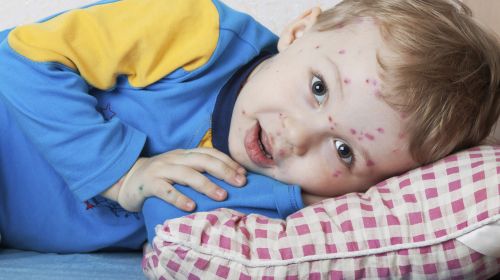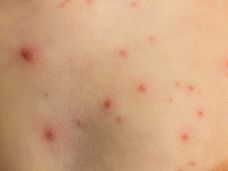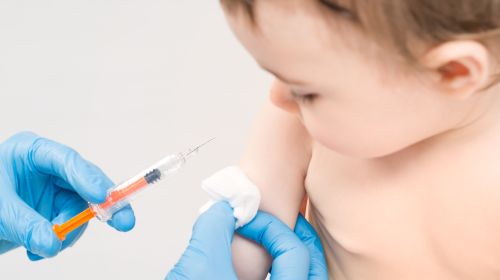Chickenpox or varicella is a highly contagious infectious disease that is caused by the herpes virus varicella zoster. The disease mainly affects children – but not only.
- Itchy chickenpox mainly affects children.
- © iStock.com/AnaDiana
The main symptom of chickenpox is an itchy rash with blisters and scabs. The infectious disease is caused by viruses, which are usually transmitted by droplet infection. Other names for chickenpox are pointed leaf, sheep leaf, or waterpox.
Article content at a glance:
Prevent chickenpox with vaccination
The vaccination against chickenpox protects very reliably against infection. For prevention, the Standing Vaccination Commission (STIKO) of the Robert Koch Institute (RKI) recommends a double chickenpox vaccination in the 11th and 15th month of life. It is possible to have the vaccination together with the triple vaccination against mumps, measles and rubella. The live vaccine contains a weakened and harmless form of the pathogen varicella zoster.
Also vaccinate people with immunodeficiency
In addition, according to STIKO, non-vaccinated adults with a weakened immune system should be immunized, as well as women who wish to have children, patients with severe neurodermatitis and people who work in the health sector.
In addition, for particularly vulnerable people, how can I get vaccinated before and during pregnancy? the possibility of getting vaccinated after contact with an infected person. This post-exposure prophylaxis is possible for up to 96 hours afterwards, but does not protect as reliably as a vaccination.
Symptoms of Chickenpox
There are some symptoms that are very typical of chickenpox, and the unclear course of the infection is rare.
The symptoms include:
Lentil-sized, pale red spots and water-containing blisters all over the body that reappear every three to four days (called "starry sky" or "star map"). The rash starts two to three weeks after being infected.
severe itching
sometimes fever up to 40 ° C
a headache
malaise
Chickenpox rash is reminiscent of a starry sky
After an incubation period of around two weeks, the first small, red nodules develop on the body with a fever. They transform into fluid-filled, itchy blisters that dry up and crust from the center. Children have around 250 skin changes during a chickenpox infection. During the healing process, this crust falls off. During the following one to two weeks, the vesicles may regenerate several times, creating the star map that is characteristic of the infectious disease.
-
© iStock.com/Mixmike
The rashes can also be found on the mucous membranes of the nose, mouth, and genital organs (especially in girls). Blisters can even form on the hairy scalp.
Complications of the viral disease
The infection with chickenpox usually heals without consequences. However, severe courses are possible in people with immunodeficiency. Chickenpox can damage the unborn child in pregnant women: Possible consequences for the child are malformations of the skeleton, eye damage, congenital skin changes or brain damage and acute danger to life.
After the illness, the virus can remain in the body without causing further symptoms. Then the virus can reactivate later when the strength of the immune system is reduced. However, this then no longer leads to chickenpox, but to shingles.
Cause of chickenpox
The varicella zoster virus belongs to the herpes viruses and spreads through droplet infection, i.e. through the air when speaking, sneezing, coughing or exhaling. The pathogen can overcome a distance of several meters. The virus can also spread to another person through the highly infectious contents of the chickenpox sores. Varicella occur seasonally more often in winter and spring.
Infected people are contagious a few days before the first blisters and up to a week after the rash has subsided. Children usually get chickenpox before they start school, unless they are vaccinated. Anyone who has gone through it once is immune to re-infection.
How does the doctor diagnose chickenpox?
On the skin, the vesicles show the typical pattern of the starry sky, so that the doctor can usually diagnose an infection with chickenpox with a visual diagnosis. The fact that the skin changes are in different healing stages helps the doctor to differentiate between chickenpox and smallpox have now been eradicated. Other childhood diseases such as measles, rubella or scarlet fever also cause red spots, but not filled blisters.
If there is still uncertainty (for example because the patient belongs to a risk group), the doctor can have a direct virus detection carried out. The virus is propagated in cell cultures and its genetic material is multiplied by means of the polymerase chain reaction. In the case of indirect virus detection, however, the antibodies that the infected person produces against the chickenpox pathogen are isolated from the blood.
Treatment: bed rest and anti-itch cream
Varicella usually subside on its own and without any long-term effects. Only in the case of an additional bacterial infection of the vesicles does the doctor prescribe an antibiotic. Severe chickenpox disease is treated with acyclovir. The antiviral suppresses the multiplication of the varicella pathogen.
Otherwise, the treatment is symptomatic, so it relieves the symptoms that are mainly caused by the itchy blisters.
Therapy of chickenpox:
As long as the patient has a fever, bed rest is the order of the day.
Special lotions relieve itching
Powder promotes the drying and healing of the blisters
Antibiotic ointments help against purulent, inflamed chickenpox
In addition, careful hygiene in the family is important:
Change laundry frequently and wash at 60 ° C
Rinse the affected person's mouth regularly with chamomile tea
You should not bathe until the chickenpox blisters have dried up, as the warmth of the water can lead to severe itching. It is better to wash the skin with a cold washcloth. After that, baths are pleasant. Exception: a hip bath with anti-inflammatory chamomile is particularly suitable if there is severe itching in the genital area.
Prevent scratching and put a child with chickenpox on sick leave
If possible, prevent your child from scratching. Because if the chickenpox becomes infected, scars can remain. It is best to cut your child's fingernails short and wash their hands more often. If you have a baby, you won't be able to prevent scratching. Soft cotton mittens help here.
Because varicella is highly contagious, sick children are not allowed to attend kindergarten or school. This applies until the rash has completely healed.
Bed rest and ointments for itching: the treatment
Varicella usually subside on its own and without any long-term effects. Only in the case of a bacterial infection of the vesicles will the doctor prescribe an antibiotic. Severe chickenpox disease is treated with aziclovir. The Antiviral curbs the multiplication of the varicella pathogen.
Otherwise, special therapy is not necessary – treatment occurs symptomatically, so it relieves the symptoms that are mainly caused by the itchy blisters.
Therapy of chickenpox:
- As long as the patient has a fever, bed rest is the order of the day.
- Special lotions relieve itching, while powder promotes the drying and healing of the blisters.
- Purulent, inflamed chickenpox is treated with antibiotic ointments.
Next to it is careful hygiene important in the family:
- Change clothes often.
- Regularly rinse the patient's mouth with chamomile tea.
- You should not bathe until the chickenpox blisters have dried up, as the warmth of the water can lead to severe itching. It is better to wash the skin with a cold washcloth. After that, baths are pleasant. Exception: A hip bath with anti-inflammatory chamomile is particularly suitable if there is severe itching in the genital area.
Prevent scratching and put a child with chickenpox on sick leave
If possible, prevent your child from scratching. Because if the chickenpox becomes infected, scars can remain. It is best to cut your child's fingernails short and wash their hands more often. If you have a baby, you won't be able to prevent scratching. Soft cotton mittens help here.
Because varicella highly contagious sick children are not allowed to attend kindergarten or school. This applies until the rash has completely healed.



